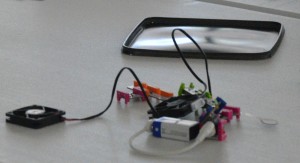Santa Fe College For Kids 2016 Space Challenge has been in full swing all week! Below are only a few of the exciting things students in the program have been involved in. Today, they’re rocketing through Day 3 of College for Kids 2016 Space Challenge! Students began building rockets, designed more complex robots, and put together circuits to power LED constellations.
They have been designing and programming even more advanced robots in their quest to explore extraterrestrial worlds – bots that even change their behavior in response to their environment! Students also learned about electric circuits, building their own strings of battery-powered LEDs and placing them in their painted canvases to display their very own light-up constellations. And last but not least, Space Challenge students began working on building their very own rockets, to be launched on campus tomorrow!
On Day ONE of the program, students built and programmed EV3 Lego rovers, painted constellations, and learned to navigate using the stars.
In Robotics, students used EV3 Lego robots and LittleBits electronic components to build bots designed to explore extraterrestrial worlds and report back data. Students also explored their artistic sides, painting canvases which were used to display the LED-powered constellations. Finally, using the Kika Silva Pla planetarium’s digital projection system, students learned how to find obscure constellations by using the brighter ones that are easy to find (i.e. Orion, the Big Dipper).
On Day TWO the students had a Q&A session with a guest speaker in the Planetarium, tested their rovers’ abilities, and worked with light and optics!
In astronomy class, Mission Analyst Mark ‘Indy’ Kochte spoke with students via a Skype video call in the Planetarium, answering questions about his involvement in the recent New Horizons mission that produced stunning HD photographs of Pluto in summer of 2015 and discussing what drove him to pursue a career in astronomy. In robotics, students began testing their EV3 LEGO robot rovers on their handling and ability to traverse terrain, and incorporated LittleBits to gather data such as temperature and light. In optics, students created a hologram using a laser, built their own 3D glasses to few their own drawings, and experimented with light and optical illusions.
